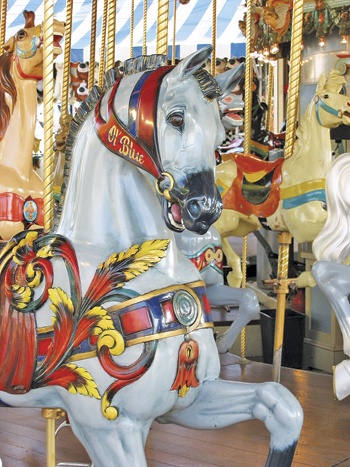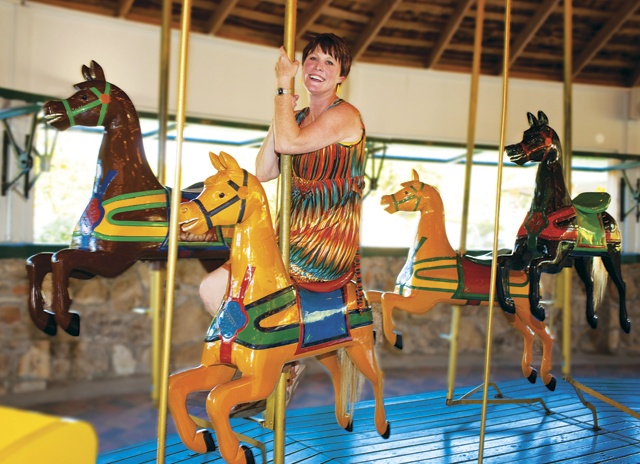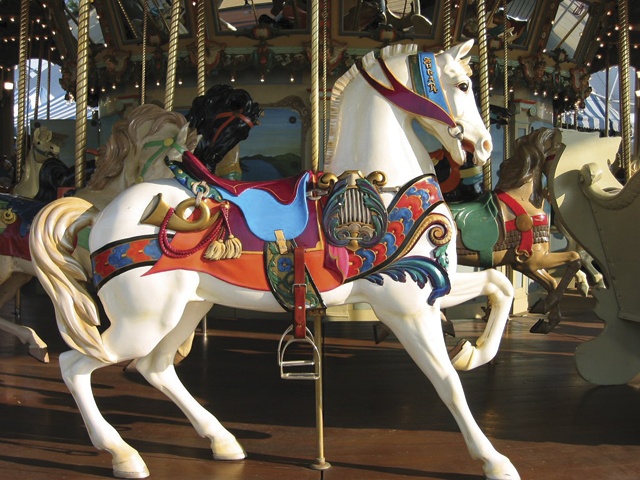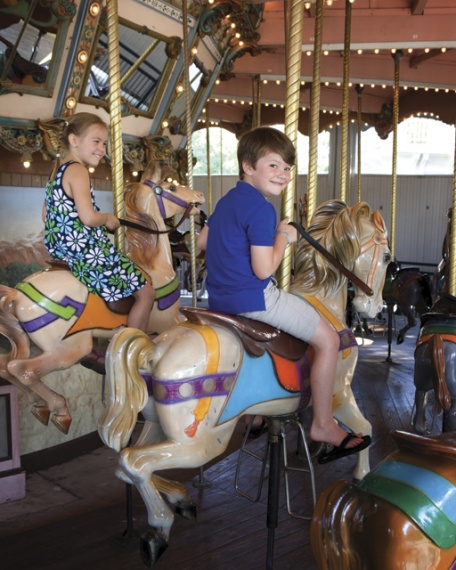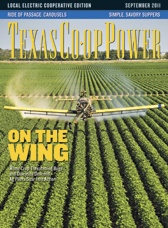A
nd the seasons they go round and round … And the painted ponies go up and down … We’re captive on the carousel of time.’
Joni Mitchell, lyrics from ‘The Circle Game’
In a world where even children’s rides seem to travel at sonic speed, there is still a place for the old-fashioned carousel. Yes, the painted ponies go up and down, and a child goes along for the ride, looking at the world go round and round with a timeless expression of wonder, delight … and maybe a little fear. This image belies the long history of the carousel, which comes to us from the Spanish word carosello, or “little battle,” in reference to rough games of horsemanship played by Arabian and Turkish riders in the 12th century.
For more than a hundred years, carousels have meant good times for generations of Americans.
The heyday of the carousel came early in the 20th century when America was growing up in a hurry and wanted to be amused in the process. Parks were built—amusement parks, no less—that helped fill the bill. The classic carousels from that era were handcrafted out of wood, intricately carved and painted to capture the horses, or other animals such as lions, tigers, giraffes, goats, pigs and roosters, in striking animated poses. They were made by people like father and son Gustav and William Dentzel, C.W. Parker, Allan Herschell, Edward Spillman, Charles Looff, Daniel Muller (considered by many to be the most creative carver of carousel animals) and many others. The work they created serves as a fragment of art history and even world history, still reflecting the carousel’s roots in war and jousting tournaments staged for the amusement of royalty.
Carousel animals, especially the horses, are frozen in time, galloping with legs outstretched, manes tousled, and with faces that can be fierce, regal, eager or terrified; in this way, they can match some of the faces of the young riders. The colors (many of the historic wooden carousel horses have been partially or completely repainted, but some original color schemes remain) are bold or subdued, mixed and matched at the pleasure of the builder. Shades of red and blue are matched with orange, brown and gold or silver leaf; and some are almost all one color. Some wear bejeweled armor, as they would have in medieval times. Others prance regally, out for a Sunday ride with the squire.
Many of the remaining carousels built during the golden age of carousels, from 1900 to 1930, have active restoration or maintenance programs. Those communities having carousels in need of repair are at least aware of the treasure they have, and many are working toward preservation.
But like the song says, we’re captive on the carousel of time, and that includes the carousels themselves. Of the estimated 5,000 classic wooden carousels that were manufactured from the 1890s until approximately 1935, only about 180 exist today, either as operational or in short-term storage (some for repairs), according to the National Carousel Association (NCA). Five of those still in operation are in Texas, though some run on a limited basis.
One of the best known is the Silver Star Carousel at Six Flags Over Texas, Arlington. Built in 1926, it is one of the last carousels manufactured by William Dentzel and Co. of Philadelphia. It operated at Rockaway Playland in Long Island, New York, until Six Flags Over Texas bought it in 1962 for $25,000 and opened it to the public the following year. Mike Apple, director of operations at Six Flags, said the park opened in 1961 with a primitive, mule-powered ride called the Flying Jenny that resembled a carousel. He doesn’t know what happened to that ride, which featured bench seats and no horses. “I guess the mule got tired,” he said.
According to Six Flags’ figures, the Dentzel carousel had been ridden more than 30 million times through 2009. That’s counting three years in the mid-1980s when it was out of service for an extensive in-house restoration.
“It’s a change of pace from some of the wild and woolly rides,” Apple said. “People remember growing up with these things. You can bring the kids out and watch them experience the same things you did when you were their age. It’s just a more relaxing ride than some of the other ones.”
In Central Texas, Brenham boasts a wooden carousel built by the C.W. Parker Co. of Leavenworth, Kansas, in 1912. Where it was between then and 1930, when Brenham resident F.C. Winkelmann found the abandoned carousel in a pasture, no one can say for sure. That same year, Winkelmann bought the carousel on behalf of the Washington County Fair Association, and it was hauled to Fireman’s Park in Brenham, where it pulled duty in the early 1930s at the county fair. The carousel has been in Brenham ever since, but, as should be expected with such finely handmade attractions, it has had its ups and downs over the years. In 2005, the city closed the carousel for repairs and restoration and had a grand re-opening in 2007.
Angela Hahn, the city’s public information manager and a carousel enthusiast, was a natural to oversee the restoration project, which was financed through a grant and private donations. Working with the NCA, she learned that the horses probably were carved by Charles Dare—one of the earliest carousel manufacturers in America who also made toys and carved rocking horses—between the late 1890s and 1905. NCA officials believe that these were Dare’s horses via one of his stylistic touches: a martingale (a strap connected to the girth and reins to keep a horse from tossing its head) on the front of the wooden horses.
NCA Census Chairman Patrick Wentzel said it wasn’t uncommon for Parker or Dentzel or other carousel makers to get horses from contractors, some of whom made horses in the “county-fair” style, meaning they were small and easily transported. The Dare horses fit this style.
In 2005, City of Brenham officials contracted woodworker Mark Spurrell to restore the horses. “He came and got them six horses at a time,” Hahn said. “He followed specs, and now we have our old carousel back.”
A 1914 Dentzel carousel at Fair Park in Dallas has been a fixture at the State Fair of Texas each autumn since 1971, thanks largely to annual off-season maintenance and res-
toration. This year is no different: Officials expect the carousel to be in action for the fair’s run from September 30 through October 23.
Wentzel notes two rare features of the Six Flags and state fair historic carousels: Both are large, four-row machines, which were more expensive to make than smaller, three-row carousels. And both are all-horse carousels.
“Dentzel carousels most always included a few menagerie animals like a lion, tiger or giraffe,” Wentzel said, adding that the state fair carousel has yet another unique feature: The outside-row standing horses are one-of-a-kind carvings, probably done by Muller, who was famous for his lifelike creations.
Fireman’s Park in Giddings has a 1915 Parker model that’s owned by the Giddings Fire Department. According to local historians, the carousel’s Giddings roots date to around 1920 when a traveling carnival couldn’t pay its bills. As the story goes, carnival officials left the carousel as collateral … and never came back to get it.
The all-horse carousel is showing its age, city officials say, and is open for riding only twice a year: the third weekend of May and July 4, during an annual fire department fundraiser. Only children may ride the horses. Adults are allowed to ride on the carousel’s benches.
Kiddie Park in San Antonio has a 1918 Herschell-Spillman carousel that, by some accounts, was in Miami for many years and then was taken on a carnival tour. In 1935, it found a home at Kiddie Park, which opened in 1925 and is recognized by the National Amusement Park Historical Association as the oldest children’s amusement park in the country.
Texas’ historic wooden carousels preserve a moment in time. Like the painted ponies of the carousel, the young riders are as frozen in time as the horses they ride, because we spend such a short time on the merry-go-round. Soon we move on to the faster, scarier rides, leaving our memories of carousels to note a particular time before we were ready for the roller coasters and tilt-a-whirls of the world. But the carousels are still around, because so many people cherish that memory and want to share it with subsequent generations.
Apple said he and the Six Flags staff realized what these old carousels can mean to people about 12 years ago, when the park began hiring senior citizens for certain jobs at the park. One of the new employees requested a job on the carousel because he had ridden it in Long Island when he was a child.
“He loved that old carousel because he remembered it from when he was a kid,” Apple said. “He named all the horses, knew everything about it. We called him Mr. Carousel.”
The man was, like the song says, captive on the carousel of time.
——————–
Clay Coppedge is a frequent contributor to Texas Co-op Power.
